The Lenovo ThinkPad X1 Yoga Review: OLED and LCD Tested
by Brett Howse & Brandon Chester on September 29, 2016 11:30 AM ESTLCD Display Analysis
Lenovo actively send us both the OLED version of the X1 Yoga (many thanks to Lenovo for helping us cover both aspects), as well as the LCD version. This gives us a chance to see how they stack up. Brandon has a deeper dive into the OLED version on the next page, and I’ve got the LCD version here.
The LCD display option supports touch since this is a convertible device, but it also has a matte coating on it. This gives the pixels themselves a bit of a washed out look, as seen above, but still gives the benefits of a matte display to the users. Lenovo offers a 1920x1080 LCD as well as the 2560x1440 version, and we recieved the larger resolution display in our review unit. The higher resolution version offers 210 pixels per inch, and they are arranged in a typical RGB stripe.
To test the display accuracy, the X1 Yoga was tested with an X-Rite i1DisplayPro Colorimeter for brightness and contrast measurements, and an X-Rite i1Pro2 Spectrophotometer for the accuracy measurements. SpectraCal’s CalMAN 5 suite is used with a custom workflow. The display is calibrated to 200 nits before accuracy results are tested.
Brightness and Contrast
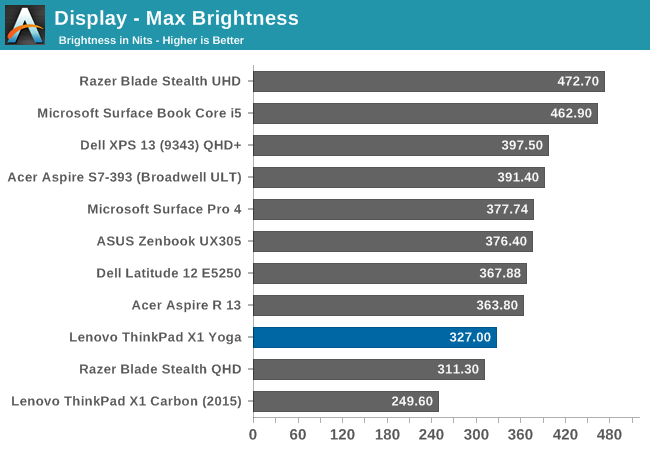
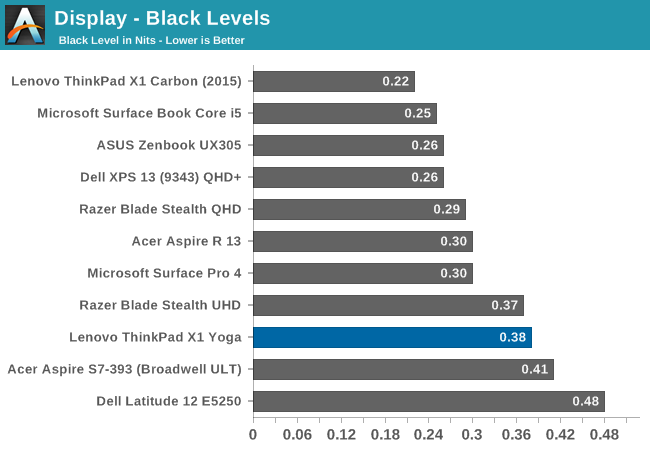
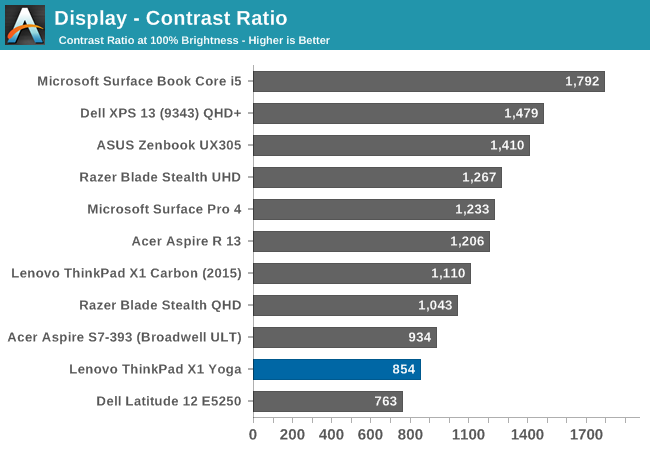
At maximum brightness, the X1 Yoga can output 326 nits, which is on the lower end of the brightness charts compared to other tested notebooks. The black levels are rather high though, which leads to a middling 854:1 contrast ratio. For those that like to use these devices at night, the minimum brightness is just 3.6 nits, which is very good.
Grayscale
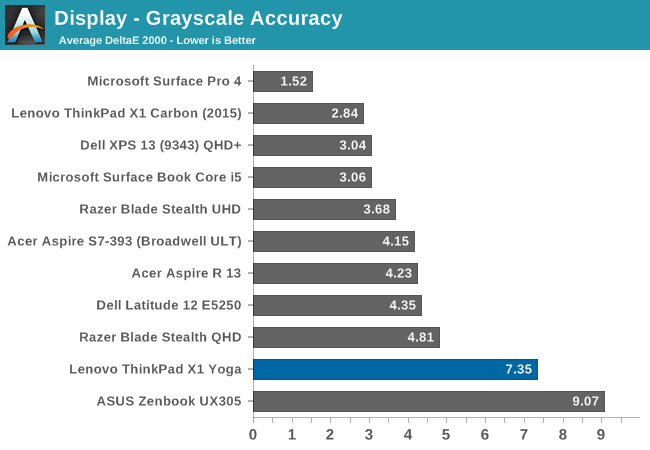
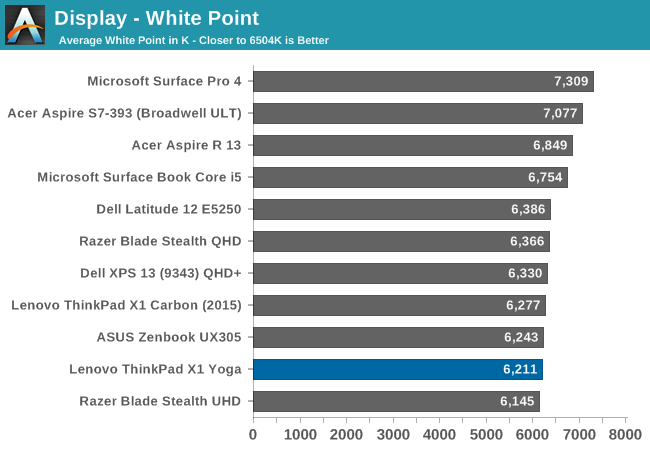
For the LCD display, the grayscale accuracy overshoots dramatically. When displaying white, there is far too much green in the image, and the blue falls away once the levels increase. This results in a display on the warm side, but with a definite green tinge to everything. At 100% white, the dE is a massive 10.8 - by contrast, when we test displays, good results are more akin to error levels under 3. The relative color comparator shows just how green the display is out of the box. For anyone remembering the Yoga 2 Pro, with its original yellow bias, this feels eerily similar.
Saturation
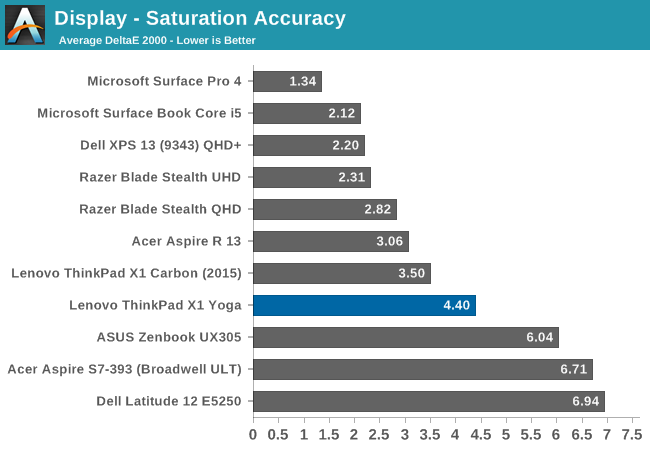
While the colored RGB sweeps are much better than the greyscale sweep, with an overall dE over 4. Red, green, and yellow, all track pretty close to the target, but the blue is off which pulls cyan and magenta off as well. It’s much better than the grayscale, but not as good as the better displays we've tested.
Gretag MacBeth
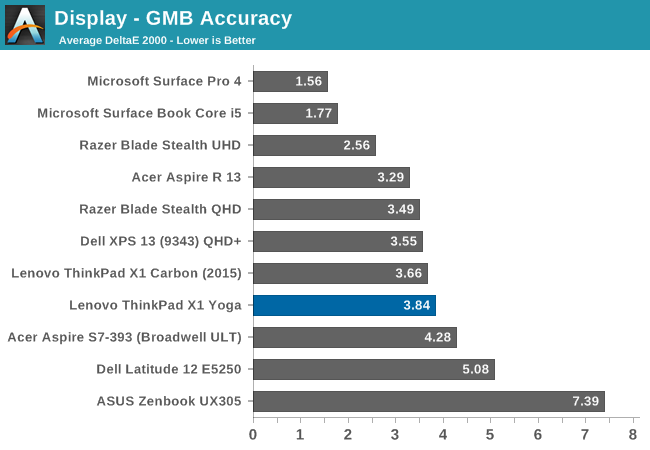
Our final out-of-the-box test is the most comprehensive, doing many more colors as well as the important skin tones. The overall dE is not too bad, at 3.8, but you can see (in the image with the boxes and dots which should all line up on a perfect device) that the grayscale once again shifts many of the colors away from the correct value, and this also impacts some of the skin tones to a high degree.
Calibrated Results
Using CalMAN to run a calibration on this display gives it a much better result on all of the tests, indicating that the panel is capable of so much more than the out-of-the-factory default settings.
We see significant gains in the grayscale sweep, but when a user attempts to calibrate a display that is this far off, a lot of the colors end up climmed as a result. It’s also difficult to calibrate for 100% white because the low blue is at maximum brightness before the other colors in the sweep. This is an issue that can’t be fixed with an ICC profile. Even with a good ICC profile, they are also not respected by many applications. This is why we typically suggest a hardware calibration at the factory to get the best results.
Overall, the default uncalibrated LCD display is a not a positive element to encourage a purchase, especially when this is a premium Ultrabook. This is one of the problems of quoting a basic gamut coverage (such as 100% sRGB) and resolution - it does not tell users who care about color accuracy the whole picture of the display.


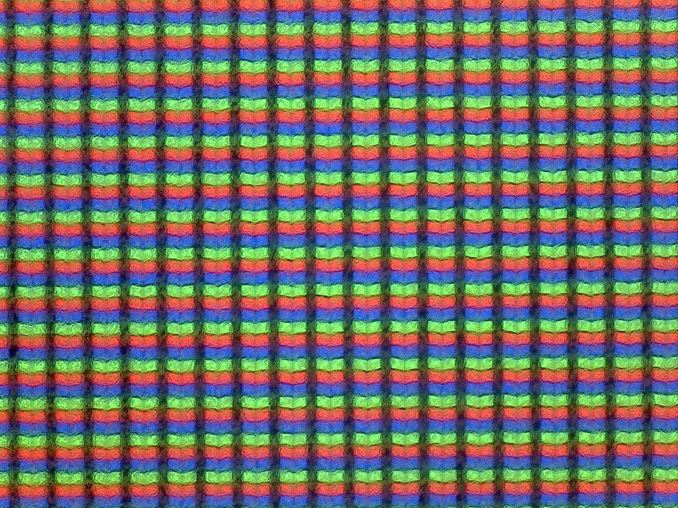






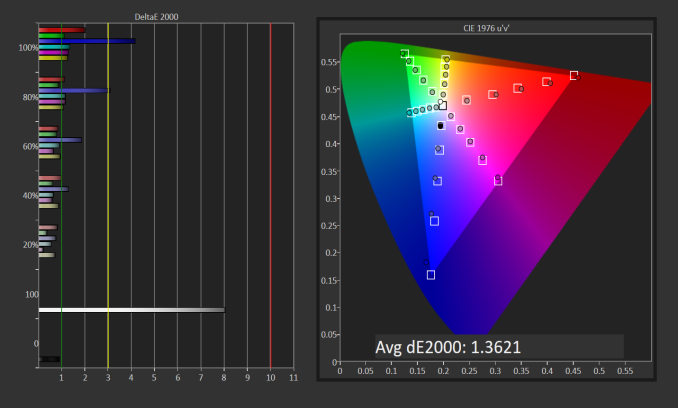
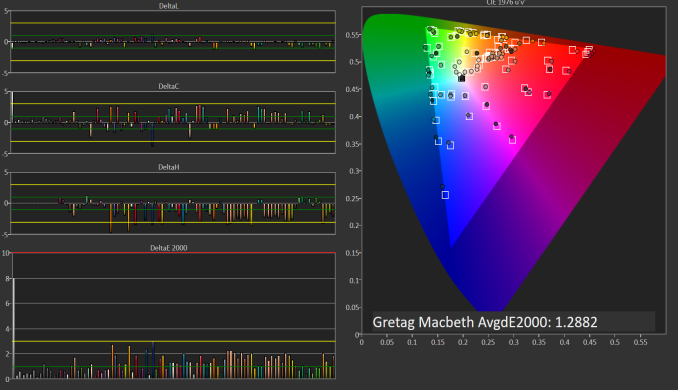








84 Comments
View All Comments
Ej24 - Thursday, September 29, 2016 - link
Nope. There are at least two or three 15w "U" processors with Iris 540 and one 28w U processor with iris 550. The 580 graphics are only reserved for HQ (35-45w) and S (65w) processors. I'd love just to have iris 540. The typical 520, 4400, or 4000 Intel graphics are hardly good enough for light gaming at 720 or heavier loads during hardware decode/encode or the 50/50 software hardware hybrid pipelines Intel has been using.Ro_Ja - Thursday, September 29, 2016 - link
All of the GeForce with *40 and below are just a waste of good money now since the Iris HD 580 can stack up against even a 940M. I can hardly find a laptop in our country without any horrible AMD EXO Pros and NVIDIA's crappy entry-level cards. I just want less heat on the laptop I want to use.spikebike - Friday, September 30, 2016 - link
I have a NUC with the Iris 540. It's pretty nice, handles the occasional light gaming, WebGL games, Minecraft, http://slither.io, and related much better than the non-iris graphics.forgot2yield28 - Friday, September 30, 2016 - link
CAD. Not a huge niche, but Iris will outperform standard intel integrated GPU. Sometimes architects/engineers want to get work done on the road. The small footprint and lightweight of an ultrabook still has appeal.Byte - Thursday, September 29, 2016 - link
Would love to get this, but all the Yogas i've had had tons of hardware bugs that were near impossible to fix. Just getting the touchpad right took a few days of fiddling. If only they can get things working.Samus - Thursday, September 29, 2016 - link
Working in IT, I can back you up on one thing for sure. These machines are hell to work on. I've had to replace two fans in Thinkpad Yoga 12.5's and they are, in traditional Lenovo fashion, not detachable from the heat pipe (which is why they failed in the first place...the bearing is in direct-contact with the source) so the whole assembly needs to be needlessly replaced, instead of just popping the cover off with a latch and unscrewing two screws like you do in just about any modern HP Elitebook.The real insult to the Thinkpad Yoga line is the dreaded history of the battery "non-recall" that caused the Yoga 14 machines to hard power off if bumped in the front right corner where the battery is connected. This connection is very sensitive and the only way we found to help prevent this anomaly was to insulate the battery connection internally on every model we came across.
Routine repair by Lenovo would result in a machine returned with the same exact problems. Dealing with Lenovo support is like dealing with a car dealership. They don't listen to your problem and the mechanic runs their standard tests, says its ok, and returns it to the customer. They don't seem to have a system in place to diagnose specific issues.
Brett Howse - Thursday, September 29, 2016 - link
It already throttles GT2. Going to GT3e would help because of eDRAM but likely throttle even more.ajp_anton - Friday, September 30, 2016 - link
Sure it throttles, nobody would expect an Iris 540 to go full speed at 15W. But with double the EUs and half the frequency, you get the same performance but at lower power (lower frequency allows for lower voltage). Wider GPUs generally have higher performance per watt because of this, at the expense of higher cost.Senti - Thursday, September 29, 2016 - link
I expect USB type-C in what you call "premium notebook" today. And better than Intel HD 520 graphics...It's sad to see that OLEDs are still "not quite ready". Battery life with web browsing was the last nail in the coffin.
BrokenCrayons - Thursday, September 29, 2016 - link
It's not bad hardware, but it does seem overpriced. Given the GPU choice, the panel resolution is too high for the graphics card to effectively drive it. 1080p is a stretch for the 520 doing anything intensive. Lenovo should offer a lower resolution & cheaper option. I can't see the usefulness of the hinge design either. Desktop operating systems work a lot better with access to a keyboard and mouse (or touchpad) so owners are probably paying for a novelty feature they'll rarely put to use.